





Spider Plants, or Chlorophytum, 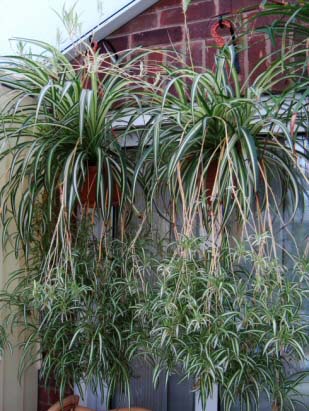 are timeless and easy to look after houseplants that originate from the tropical and southern regions of Africa. They are potentially one of the easiest and rewarding indoor plants you can grow. A Spider Plant does need some attention in order to really make it perform at its best, but it's extremely tolerant should you accidentally forget about it from time to time. This is in part due to the thick white roots, or rhizomes, it produces in order to store food and moisture for long term support.
are timeless and easy to look after houseplants that originate from the tropical and southern regions of Africa. They are potentially one of the easiest and rewarding indoor plants you can grow. A Spider Plant does need some attention in order to really make it perform at its best, but it's extremely tolerant should you accidentally forget about it from time to time. This is in part due to the thick white roots, or rhizomes, it produces in order to store food and moisture for long term support.
One of the most interesting points of the Spider Plant is its ability to rapidly propagate itself, through us, people! A "baby" or "pup" from the mother plant will often root with a very high success rate and within a year it's producing babies of its own to give out to your family and friends. Children love it and adults too.
There are quite a few different varieties or "cultivars" which you can find, the arguably four most common are detailed below. After comparing your own Spider Plants leaves with the pictures below you may find yours isn't listed here. However in all cases Chlorophytums have very similar care requirements so the information should still be relevant.
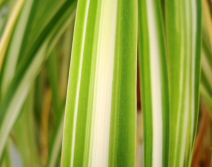 Chlorophytum Comosum "Vittatum" - This was the first variegated cultivar of the Spider Plant and was the most popular until the late 1990s. It has mid-green leaves with a broad central white stripe. It's often displayed in hanging baskets to display the numerous plantlet's or Spider Babies that form on mature plants. The long stems on which the Babies hang are yellow / white.
Chlorophytum Comosum "Vittatum" - This was the first variegated cultivar of the Spider Plant and was the most popular until the late 1990s. It has mid-green leaves with a broad central white stripe. It's often displayed in hanging baskets to display the numerous plantlet's or Spider Babies that form on mature plants. The long stems on which the Babies hang are yellow / white.
 Chlorophytum Comosum "Variegatum" - This version is newer than the 'Vittatum', and has dark green leaves with white margins. It's generally more compact than the previous cultivar. The long stems which support the offsets are green. It's a striking plant and has generally replaced the popularity of the 'Vittatum' in garden centers and department stores.
Chlorophytum Comosum "Variegatum" - This version is newer than the 'Vittatum', and has dark green leaves with white margins. It's generally more compact than the previous cultivar. The long stems which support the offsets are green. It's a striking plant and has generally replaced the popularity of the 'Vittatum' in garden centers and department stores.
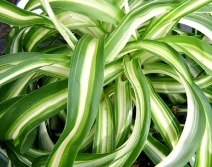 Chlorophytum Comosum "Bonnie" - has the traditional green with white stripe variegation of the ‘Vittatum’ but it's leaves curl and bend. The flowering stems are yellow and plantlet's are curly like the parent. It is fast becoming a very popular variety as it tends to be very compact in size and is ideal if you want a Spider Plant but don't have masses of space in which to show it off.
Chlorophytum Comosum "Bonnie" - has the traditional green with white stripe variegation of the ‘Vittatum’ but it's leaves curl and bend. The flowering stems are yellow and plantlet's are curly like the parent. It is fast becoming a very popular variety as it tends to be very compact in size and is ideal if you want a Spider Plant but don't have masses of space in which to show it off.
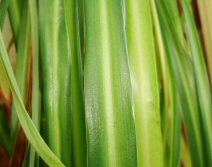 Chlorophytum comosum - This was potentially the original Spider Plant. Its leaves are all green with a slightly lighter green shade running through the center and although it's better adapted to darker positions than the variegated versions it's the least common. You will struggle to find this type in the average garden center, so if you decide you want it you may have to search a bit further a field.
Chlorophytum comosum - This was potentially the original Spider Plant. Its leaves are all green with a slightly lighter green shade running through the center and although it's better adapted to darker positions than the variegated versions it's the least common. You will struggle to find this type in the average garden center, so if you decide you want it you may have to search a bit further a field.
Light
All the variegated Spider Plants need a bright spot in order to keep their stripes. The all green version (which has no variegation to lose) will accept a darker location although growth will be much slower. Direct sunlight should always be avoided.
Watering
Water your Spider Plant liberally in the growing months (Spring through to Autumn / Fall) and you will get a good rate of growth and a high chance of Spider Babies. Water only sparingly in Winter as growth slows regardless at this time or year and too much unused water can trigger rotting.
Humidity
Not important.
Feeding
Don't feed newly planted Spider Babies / Pups, or the mature plants in the Winter months. Otherwise feel free to feed every few weeks.
Temperature
If the soil is dry it will survive without issue down to 5°C / 41°F. If the soil is wet or you go colder than this, some damage will likely result. Any exposure to a hard frost will totally destroy the plant over night. The average warmth of a typical home is the key to good growth.
Repotting
If ideal care has been provided, you will end up repotting the plant each spring until it reaches maturity (2 to 5 years). It's always best and very easy to propagate Spider Plants by their offsets, some people also divide the plant when they repot. If you don't want to divide yours but you're worried it's too big and you aren't able to move it to a different location, don't repot into a larger container and this will restrict its growth.
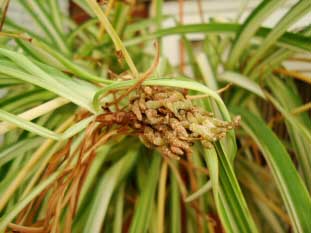
Propagation
Always through the "Spider Babies" or "Pups" (it's so easy!). Methods:
1) If the babies have been hanging on the parent plant for while and have their own roots (see picture right), you can cut them off the flowering stem and push them directly into a pot filled with moist compost. There is no need to use any type of rooting hormone. Water well and put in a bright (not sunny) spot. Keep moist, and within a few weeks you will notice new leaf growth.
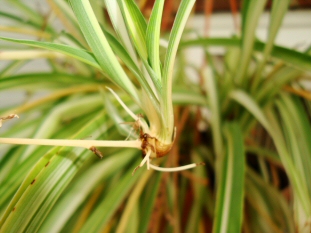 2) If the babies are young and have no roots yet (see picture right), cut them off from the flowering stem and hang them in a container of water (the leaves shouldn't be submerged, just the root area needs to make contact with the water). In a few weeks you will have roots and you can follow the directions in 1) above.
2) If the babies are young and have no roots yet (see picture right), cut them off from the flowering stem and hang them in a container of water (the leaves shouldn't be submerged, just the root area needs to make contact with the water). In a few weeks you will have roots and you can follow the directions in 1) above.
3) The methods described above are the simplest, However you can also "peg" the babies into nearby soil with them still attached to the flowering stem (and therefore the parent). Rooting should take place in a few weeks, at which point you can cut them away from the flowering stem.
Which ever method you pick, in about a month you will have something like the picture below. Spider Plants are fast growers!
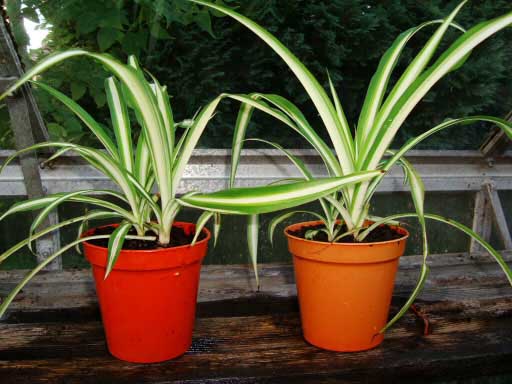
Speed of Growth
The Spider Plant is one of the fastest indoor growing plants you can find. Providing you give it good light levels and just the right amount of water.
Height / Spread
The maximum height and spread of most Spider Plants is around 30cm / 12in.
Flowers
Mature plants will produce a rapidly growing flowering stem on which small white flowers appear. The Spider Babies form from these flowers a short time later.
Anything else?
If you have a large enough hanging basket you can plant several babies together to create a future cascading waterfall of babies! (see picture at the top of the article or image 4 in the gallery, each basket has two fully mature and independent plants). Very effective in a conservatory or anywhere where you have height such as the top of cupboards.
Copyright © www.100flowers.win Botanic Garden All Rights Reserved